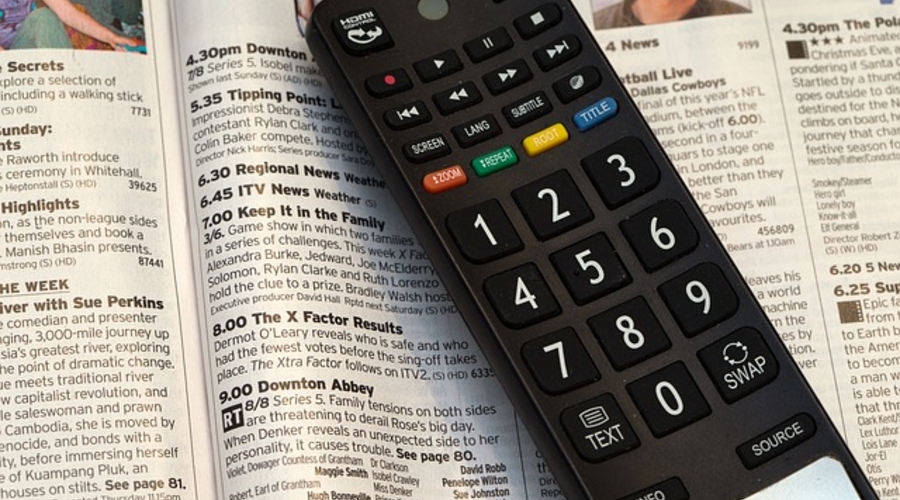Work is underway to increase the level of accessibility on British programming and digital services.
While accessibility on British television is among the best in the world, according to the RNIB, there is still work to be done.
"We're the envy of the world, really," says Steve Tyler, Head of Solutions, Strategy and Planning at the RNIB, who says that many broadcasters are voluntarily exceeding the minimum 10% of programmes with audio description (AD) provision required by the regulator.
Audio description is the use of extra narration to depict extra details, such as body language or expressions, to viewers who are visually impaired.
"TV and blind people, in most people's minds, simply don't go together. But actually, the majority of blind people, like everybody else, use TV as their key source of information and entertainment," says Tyler.
While public service broadcasters are surpassing audio description targets, there is still a long way to go to give those with sight issues equal access to programmes.
The rapid growth of on demand programming has so far failed to provide sufficient access services, leading the RNIB to develop a new smart phone app, which will liberate users from their televisions.
The MovieReading app, which is currently being tested by 150 blind and partially sighted people, syncs audio description with the soundtrack of a film or television programme, and delivers AD in real time.
"Our attitude is [that] we want to understand the business constraints of the industry, if there are genuine implementation problems then look, here is a solution that you can deliver with very little input."
"TV and blind people, in most people's minds, simply don't go together"
However, campaigners like Tyler would prefer if on demand services like Netflix and Amazon Prime offered their own accessibility services.
"Our ideal is that they deliver via the net in the ordinary way because the app's great for people are technically savvy and switched on to the whole idea, but a great many people are not. Over half of our population, I would say, is just nowhere near apps and smartphones."
While audio description is the current priority for helping those with sight loss access television, for hearing loss campaigners, there is a drive to improve subtitling provisions.
There is currently no European or British legislation in place to require subtitles for on demand content, however Ofcom have teamed up with the Authority for Television On Demand (ATVOD) to help on demand services improve their access facilities.
Meanwhile, Action on Hearing Loss, formerly known as the Royal National Institute for Deaf People, is working with Ofcom to focus on the quality and quantity of subtitled programmes across the board.
"Quality has been an issue for a long time," says the charity's Senior Research and Policy Officer, Laura Matthews.
For Matthews, reducing a dependency on live subtitling, used in both live broadcasts and on programmes transmitted shortly after recording, such as Have I Got News For You, is key to raising the standard of subtitles.
"We are seeing signs that broadcasters are trying to reduce the number of pre-recorded programmes that have to be subtitled live," says Ofcom's Head of TV Content Policy, Peter Bourton, who is half way through a two year exercise to improve the quality of live subtitling.
A recent report by the regulator found that entertainment programmes had the highest quality of subtitling, while on average chat shows were failing to meet the acceptable accuracy threshold.
Latency is another area where Ofcom are working with broadcasters to improve quality. According to Bourton, subtitles on shows such as Gogglebox can be difficult for users to follow, as the picture on screen quickly switches between dialogue from programme clips and the reactions of the Goggleboxers.
Matthews adds that similar editing is also confusing for those with partial deafness, who rely on lip reading to follow a programme.
"Gone are the days where we could deliver braille TV Times with just five channels"
"Background noise, such as music, is distracting, while strong accents and mumbling make it hard to lip read," she says, referring to the issues surrounding the BBC's recent production of Jamaica Inn.
Away from television content, the growing number of channels available presents a challenge for those who are unable to browse the electronic programming guide (EPG).
"Gone are the days where we could deliver braille TV Times with just five channels," says Tyler.
Instead, the RNIB has developed middleware which can be inserted into set top boxes and digital televisions to enable accessibility, allowing for changes in font and colour contrast in the menu and the EPG, and for all content to be delivered through synthetic speech.
As television technology continues to develop at a rapid rate, it seems that charities such as the RNIB and Action on Hearing Loss will need to continue to work closely with regulators to ensure that broadcasters and manufacturers offer reliable access services to those with visual and hearing impairments.
By Pippa Shawley

